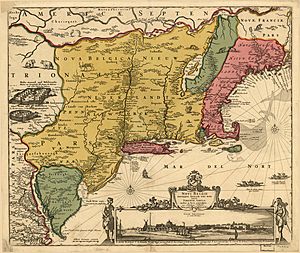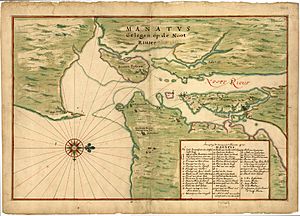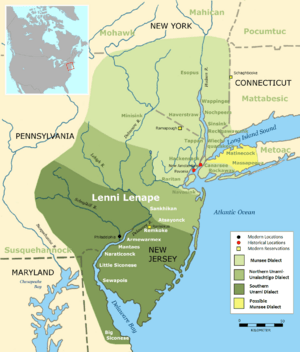Pavonia, New Netherland facts for kids
Pavonia was one of the first European settlements on the west side of the Hudson River. It was part of a Dutch province called New Netherland in the 1600s. Today, this area is known as Hudson County, New Jersey.
Contents
Early Explorers and Native Americans

The first European to write about this area was Robert Juet in 1609. He was the first mate on the ship Halve Maen (meaning Half Moon). This ship was led by Henry Hudson, an English captain working for the Dutch East India Company. They explored the Kill van Kull and Newark Bay, and anchored near Weehawken Cove.
By 1617, the Dutch set up a factorij, or trading post, at Communipaw. These posts were used to trade furs with the local people. The area was home to different groups of Lenni Lenape people, who spoke Algonquian languages. These groups were later called the Delawares. One group, known as the Hackensack, lived in this region. Other groups included the Tappan, Wappinger, Raritan, and Canarsee. Settlers later called them "the River Indians."
The Patroon System
In 1625, the Dutch built Fort Amsterdam at the southern tip of Manhattan Island. In 1629, the Dutch West India Company started a system called "patroonship." This allowed important members of the company to become "patroons" and own large areas of land. A patroon received powerful rights, like setting up courts and choosing local leaders. In return, they had to bring at least 50 families to settle on their land within four years. These first settlers didn't have to pay public taxes for ten years, but they did pay the patroon with money, goods, or services.
One of these land grants was given to Michael Pauw. He was a leader in Amsterdam and a director of the Dutch West India Company. The name Pavonia is the Latin form of Pauw's last name, which means "peacock."
Pauw bought the land from the local Native Americans. However, the Native Americans and Europeans had very different ideas about land ownership. Three Lenape people "sold" the land for items like shell beads (called wampum), cloth, kettles, guns, and beer. These sales happened in 1630. It's believed these were the same people who had "sold" Manhattan Island a few years earlier.
Early Settlements in Pavonia
Pauw's land in Pavonia likely covered about 8 miles (13 km) along the Hudson and Hackensack Rivers. His agent set up a small trading post and ferry crossing at Arresick, which is now called Paulus Hook. He ran a ferry and traded with the Lenape people. By 1630, a farm worked by African slaves was also set up.
However, Pauw did not bring enough settlers to his land. So, he had to sell it back to the Dutch West India Company. The company then built a home at Gemoenepaen in 1633 for their representative, Jan Evertsen Bout. Another home was built at Ahasimus in 1634 for Cornelis Hendriksen Van Vorst. His family later became very important in the development of Jersey City.
Other small farms and settlements appeared, like at Kewan Punt. The first brewery in North America was located at Hobuk (Hoboken). Even though these settlements were small, they were important. They gave the Dutch a foothold on the west side of the Hudson River, across from New Amsterdam. They were also key trading posts for settlers and Native Americans, especially for valuable beaver furs.
The Pavonia Massacre and Kieft's War
Relations between the Dutch and the Lenape were often difficult. They misunderstood each other's trade agreements, land ownership ideas, and ways of life. Language differences also made things harder. These problems led to growing tensions and eventually to a series of attacks and counter-attacks known as Kieft's War.
Willem Kieft became the Director-General of New Netherland in 1639. He wanted to increase profits from the port at Pavonia. He tried to demand payments from the Native Americans, claiming it would protect them from rival groups. The Native Americans ignored his demands.
Conflicts were already happening. Dutch soldiers attacked a Native American camp on Staten Island because pigs were stolen (though other settlers actually stole them). The death of a Dutch worker, Claes Swits, by a Weckquaesgeek (a Wappinger group) also angered many Dutch settlers.
Against the advice of his own council, Kieft decided to attack Native Americans who had sought safety among the Dutch settlers. These Native Americans were fleeing attacks from Mahican tribes from the north. On February 25, 1643, Kieft ordered an attack at Communipaw. This attack was a massacre: 129 Dutch soldiers killed 120 Native Americans, including women and children. This event is often called the Pavonia Massacre. A similar, smaller attack happened in Manhattan the same night. The Native Americans called it "The Slaughter of the Innocents."
This attack united the different Algonquian peoples in the area like never before. On October 1, 1643, a united force of Native American tribes attacked the settlements at Pavonia. Most of the homes were burned down. Many settlers were killed, and those who survived were ordered to the safer area of New Amsterdam. Pavonia was completely emptied.
For the next two years, during what became known as Kieft's War, the united tribes attacked settlers across New Netherland. The small European forces struggled to stop the attacks. Finally, a truce was agreed upon in August 1645, partly helped by the Hackensack leader, Oratam. Kieft was called back to the Netherlands in 1647 to explain his actions, but he died in a shipwreck before he could tell his side of the story. This war was very bloody for the time, with over 1,600 Native Americans killed. The European population of New Amsterdam was only about 250. After the war, the uneasy peace allowed for new settlements like Constable Hook (1646) and Awiehawken (1647).
The Peach War and Bergen
Peter Stuyvesant took over after Kieft. In 1653, Pavonia became part of the new city of New Amsterdam. More land grants were made in late 1654 in areas like Pamrapo, Minkakwa, and Kewan.
The colony grew, and things were mostly peaceful until 1655. That year, Pavonia and Staten Island were attacked by about 500 united Lenape warriors. 50 settlers were killed, and over 100 were taken hostage. They were held at Paulus Hook until they could be released through talks. This event is known as the Peach War. It is said to have started when a young Lenape woman was killed for stealing a peach from a settler's orchard in Manhattan. However, it might also have been a response to the Dutch attack on New Sweden, which was a trading partner of the Lenape on the Delaware River.
In 1658, Stuyvesant wanted to make formal agreements with the Lenape. He agreed to "re-purchase" the land between the Hudson and Hackensack rivers, stretching down to the Kill Van Kull in Bayonne. A mural in the Hudson County Courthouse shows this event. On January 30, 1658, this land was bought from the Native Americans and given to the people of Bergen in 1661.
A new village was founded at what is now Bergen Square. Settlers wanted to return to the west side of the Hudson. They named it Bergen. The Dutch word berg means hill, and bergen means a place of safety. Stuyvesant granted Bergen its own government on September 5, 1661. This was part of his effort to regain control of the Hudson River's western shore and expand beyond New Amsterdam. Bergen was located on Bergen Hill, part of the original patroonship. It was the first self-governing European settlement in what would become the state of New Jersey.
In 1664, Fort Amsterdam and all of New Netherland peacefully surrendered to the British. For the next ten years, the land was traded back and forth. The Dutch briefly recaptured it, but finally gave up control with the Treaty of Westminster in 1675. Bergen's charter was renewed by the new government, and the area kept its Dutch character for many years.
Pavonia Today
While the entire region was once called Pavonia, the name today mostly refers to parts of Jersey City. This includes areas like Harsimus Cove, Hamilton Park, and the WALDO-Powerhouse.
Since the 1980s, the former site of the Erie Railroad's Pavonia Terminal and the Pavonia Ferry has been redeveloped into a modern area called Newport. The PATH train system has a station there called Newport Station (formerly Pavonia). The Hudson Bergen Light Rail also has a stop called Pavonia-Newport station in this part of the city.
Pavonia Avenue is a street that runs through different parts of Jersey City, including Newport, Hamilton Park, Journal Square, and the Marion Section. Pavonia Court in Bayonne is named after the Pavonia Yacht Club, which was founded in 1859. There is also a Pavonia Avenue in Kearny.
Saint Peter's College, located on land that was once part of the original patroonship, has a peacock as its mascot. This is a nod to Michael Pauw, whose name means "peacock." The college's newspaper is called Pauw Wow, and its literary magazine is Pavan. There is also a Pavonia Branch of the Jersey City Free Public Library.
See also
 In Spanish: Pavonia (Nuevos Países Bajos) para niños
In Spanish: Pavonia (Nuevos Países Bajos) para niños








